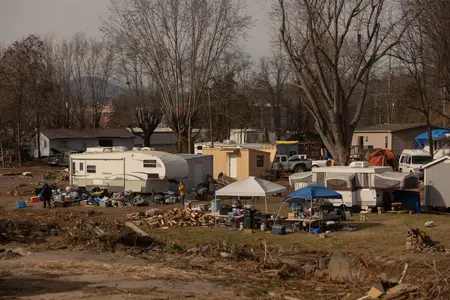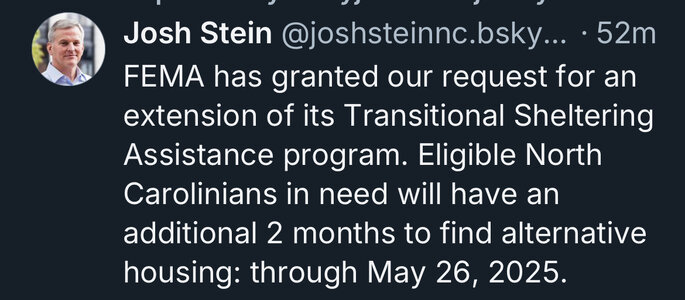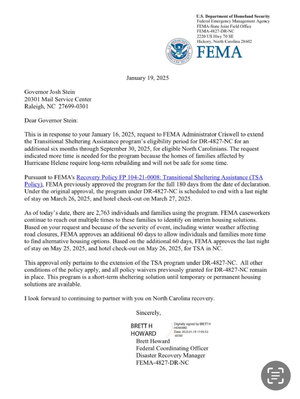Navigation
Install the app
How to install the app on iOS
Follow along with the video below to see how to install our site as a web app on your home screen.
Note: This feature may not be available in some browsers.
More options
You are using an out of date browser. It may not display this or other websites correctly.
You should upgrade or use an alternative browser.
You should upgrade or use an alternative browser.
Helene Recovery & Info
- Thread starter TullyHeel
- Start date
- Replies: 1K
- Views: 45K
- Off-Topic
donbosco
Legend of ZZL
- Messages
- 5,529
Code Purple has been called for Asheville and Buncombe County to provide emergency shelter for those experiencing homelessness during cold weather.Code Purple is a coordinated effort to increase emergency shelter capacity with fewer requirements than typical programming. Participating sites will also connect individuals to long-term shelter and housing options.Code Purple Shelter
Sites:ABCCM (Single Men)Location: 20 20th StreetPhone:
828-259-5333
Hours: Intake: 4–8 p.m. | Exit: 7:30 a.m.Transit Route: WE2 Bear Creek RdABCCM’s Transformation Village (Single Women & Women with Children)Location: 30 Olin Haven WayPhone:
828-259-5365
Hours: Intake: 4–8 p.m. | Exit: 7:30 a.m.Transit Route: W2
Transportation Details:- Free ART Bus Transit: Available to and from Code Purple sites. Riders must inform drivers they’re going to a Code Purple site.- ABCCM Shuttle: Picks up at Crisis Ministry (24 Cumberland Ave.) at 4 p.m.- Community Support: Paramedics, AFD-REST, and Mission Hospital can assist with transportation for those unable to access bus services.For additional weather updates, visit weather.gov.Please note: Families will be triaged on a case by case basis, and may be offered hotel options if no other shelters are available. Both locations are wheelchair accessible
Sites:ABCCM (Single Men)Location: 20 20th StreetPhone:
828-259-5333
Hours: Intake: 4–8 p.m. | Exit: 7:30 a.m.Transit Route: WE2 Bear Creek RdABCCM’s Transformation Village (Single Women & Women with Children)Location: 30 Olin Haven WayPhone:
828-259-5365
Hours: Intake: 4–8 p.m. | Exit: 7:30 a.m.Transit Route: W2
Transportation Details:- Free ART Bus Transit: Available to and from Code Purple sites. Riders must inform drivers they’re going to a Code Purple site.- ABCCM Shuttle: Picks up at Crisis Ministry (24 Cumberland Ave.) at 4 p.m.- Community Support: Paramedics, AFD-REST, and Mission Hospital can assist with transportation for those unable to access bus services.For additional weather updates, visit weather.gov.Please note: Families will be triaged on a case by case basis, and may be offered hotel options if no other shelters are available. Both locations are wheelchair accessible
- Messages
- 1,102
From a friend who lives in Asheville:
It is good to get away from Asheville right now. Winter has come in strong after a hot, dry fall. It's almost like we went from summer, to Helene, to summer, to winter.
There's still a lot of cleanup everywhere, and a lot of unhoused people. Lots of damage, loss, and sadness. Asheville will never be the same I'm afraid. And whatever form recovery does take is going to take years.
It is good to get away from Asheville right now. Winter has come in strong after a hot, dry fall. It's almost like we went from summer, to Helene, to summer, to winter.
There's still a lot of cleanup everywhere, and a lot of unhoused people. Lots of damage, loss, and sadness. Asheville will never be the same I'm afraid. And whatever form recovery does take is going to take years.
donbosco
Legend of ZZL
- Messages
- 5,529
Rolling Around #WNC This Winter This Is What You See.


 carolinapublicpress.org
carolinapublicpress.org


NC mountain housing woes headed for crisis, months after Helene
An already difficult housing market in Western NC has grown worse due to storm. Slow relief, high rents, unlivable homes drive homelessness.
- Messages
- 3,658
I find it hard to believe a White Evangelical preacher would be involved in Fraud lol
Mulberry Heel
Inconceivable Member
- Messages
- 3,574
If he or his church ran a private or charter "Christian" school funded by state vouchers it would be perfect.I find it hard to believe a White Evangelical preacher would be involved in Fraud lol
evrheel
Esteemed Member
- Messages
- 532
Terrible time to suffer a wildfire disaster. Trump is not in favor of providing aid for those hurt by wildfires
donbosco
Legend of ZZL
- Messages
- 5,529
"Come Hell or High Water is a community memory project to collect, preserve, and present the stories and digital record of the Western North Carolina communities impacted by Tropical Storm Helene. We hope to offer pathways for community reflection, healing, and long-term development of community memory not afforded victims of past disasters."

 specialcollections.buncombecounty.org
specialcollections.buncombecounty.org

Come Hell or High Water
In late September 2024, Tropical Storm Helene ripped through Western North Carolina. Helene eclipsed the Great Flood of 1916, and is now the most significant natural disaster in our region’s r…
donbosco
Legend of ZZL
- Messages
- 5,529
From a "listserve"(NextDoor) associated with Buncombe County.
"My husband and I spent the months since Helene cleaning up and repairing damage caused to our property by high winds. More than 30 trees were toppled. We are both 73 and have no family nearby, making the process difficult and at times overwhelming. While dealing with this, we decided we had reached a time in our lives when we should move out of our house into independent living. We did this, but now we find ourselves living in another nightmare. We can’t sell our house. A prospective buyer, who loved our house but decided not to buy it, informed us that our house supposedly has a 99.9% chance of flooding in the next 30 years. This led to the discovery that most if not all major real estate websites now display climate risk factors generated by First Street, a climate risk financial modeling firm based in New York. First Street assigned our property at 17 Bohemian Lane, Asheville, NC, a 10/10 Extreme flood risk factor, their highest rating. This is absurd:
1. It is physically impossible for our property to flood. It’s located above 2500 feet on sloping terrain. Water cannot collect on it. During Helene and the three days preceding the storm, an estimated 18 to 22 inches of rain fell where we live. There was no flooding on our property—none. Rainwater drained down the mountainsides and flooded valleys. Mountain tops and mountain sides did not flood, not even during Helene.
2. The flood risk designations First Street’s has assigned to our property and to our next-door neighbors’ (downhill from us) defy the laws of physics and logic. First Street says our property has a 10/10 Extreme flood risk, while the adjacent property and the one next to it have a 1/10 Minimal flood risk. It’s not possible for adjacent properties to have polar opposite flood risks. Water doesn’t stay within property lines. Moreover, our house is at the highest elevation among the three, and water flows downhill.
3. Both FEMA and the North Carolina Emergency Management Flood Risk Information System (NCEM FRIS) place our property in Zone X (unshaded), their lowest ratings. First Street’s methodology is clearly flawed. Yet, they refuse to make corrections. The dispute policy on their website states this: “If you contact customer support regarding a score dispute, you should not expect a personalized response."Real estate websites likewise have refused to remove First Street’s erroneous flood risk information, with one exception.
Realtor.com removed the flood risk information for our property.We filed a complaint with the BBB and have written dozens of emails to real estate websites, realtor associations, state and federal senators and representatives, our governor, the NC DOJ, the FTC, FEMA, and new media. Most haven’t responded. The rest can't or won't help.
Worse yet, we are far from alone, as evidences by unresolved complaints to the Better Business Bureau and online discussions in which other people share stories similar to ours. First Street Technology, Inc. | BBB Complaints | Better Business BureauFirststreet is rated "Poor" with 2.3 / 5 on Trustpilot
If you want to see how First Street rates your property, go to their website: firststreet.org. Put in your address at the top of the page. First Street, claiming to be highly scientific and accurate, is aggressively marketing its faulty flood risk data to real estate, insurance, and mortgage companies; and to the public--and many are literally and figuratively buying it. You can see it on their website (The Standard for Climate Risk Financial Modeling) as well as in articles like this: https://www.cnn.com/2025/05/19/climate/flooding-credit-homeowners-insurance. First Street is destroying property values and squelching home sales nationwide with faulty data. One of the blessings of Helene was experiencing how people came together to help one another through the worst of it. I hope and pray that good people working together can raise awareness and work together to stop this company's destruction and repair the damage already done."
"My husband and I spent the months since Helene cleaning up and repairing damage caused to our property by high winds. More than 30 trees were toppled. We are both 73 and have no family nearby, making the process difficult and at times overwhelming. While dealing with this, we decided we had reached a time in our lives when we should move out of our house into independent living. We did this, but now we find ourselves living in another nightmare. We can’t sell our house. A prospective buyer, who loved our house but decided not to buy it, informed us that our house supposedly has a 99.9% chance of flooding in the next 30 years. This led to the discovery that most if not all major real estate websites now display climate risk factors generated by First Street, a climate risk financial modeling firm based in New York. First Street assigned our property at 17 Bohemian Lane, Asheville, NC, a 10/10 Extreme flood risk factor, their highest rating. This is absurd:
1. It is physically impossible for our property to flood. It’s located above 2500 feet on sloping terrain. Water cannot collect on it. During Helene and the three days preceding the storm, an estimated 18 to 22 inches of rain fell where we live. There was no flooding on our property—none. Rainwater drained down the mountainsides and flooded valleys. Mountain tops and mountain sides did not flood, not even during Helene.
2. The flood risk designations First Street’s has assigned to our property and to our next-door neighbors’ (downhill from us) defy the laws of physics and logic. First Street says our property has a 10/10 Extreme flood risk, while the adjacent property and the one next to it have a 1/10 Minimal flood risk. It’s not possible for adjacent properties to have polar opposite flood risks. Water doesn’t stay within property lines. Moreover, our house is at the highest elevation among the three, and water flows downhill.
3. Both FEMA and the North Carolina Emergency Management Flood Risk Information System (NCEM FRIS) place our property in Zone X (unshaded), their lowest ratings. First Street’s methodology is clearly flawed. Yet, they refuse to make corrections. The dispute policy on their website states this: “If you contact customer support regarding a score dispute, you should not expect a personalized response."Real estate websites likewise have refused to remove First Street’s erroneous flood risk information, with one exception.
Realtor.com removed the flood risk information for our property.We filed a complaint with the BBB and have written dozens of emails to real estate websites, realtor associations, state and federal senators and representatives, our governor, the NC DOJ, the FTC, FEMA, and new media. Most haven’t responded. The rest can't or won't help.
Worse yet, we are far from alone, as evidences by unresolved complaints to the Better Business Bureau and online discussions in which other people share stories similar to ours. First Street Technology, Inc. | BBB Complaints | Better Business BureauFirststreet is rated "Poor" with 2.3 / 5 on Trustpilot
If you want to see how First Street rates your property, go to their website: firststreet.org. Put in your address at the top of the page. First Street, claiming to be highly scientific and accurate, is aggressively marketing its faulty flood risk data to real estate, insurance, and mortgage companies; and to the public--and many are literally and figuratively buying it. You can see it on their website (The Standard for Climate Risk Financial Modeling) as well as in articles like this: https://www.cnn.com/2025/05/19/climate/flooding-credit-homeowners-insurance. First Street is destroying property values and squelching home sales nationwide with faulty data. One of the blessings of Helene was experiencing how people came together to help one another through the worst of it. I hope and pray that good people working together can raise awareness and work together to stop this company's destruction and repair the damage already done."
waynecountywolf
Active Member
- Messages
- 45
From a "listserve"(NextDoor) associated with Buncombe County.
"My husband and I spent the months since Helene cleaning up and repairing damage caused to our property by high winds. More than 30 trees were toppled. We are both 73 and have no family nearby, making the process difficult and at times overwhelming. While dealing with this, we decided we had reached a time in our lives when we should move out of our house into independent living. We did this, but now we find ourselves living in another nightmare. We can’t sell our house. A prospective buyer, who loved our house but decided not to buy it, informed us that our house supposedly has a 99.9% chance of flooding in the next 30 years. This led to the discovery that most if not all major real estate websites now display climate risk factors generated by First Street, a climate risk financial modeling firm based in New York. First Street assigned our property at 17 Bohemian Lane, Asheville, NC, a 10/10 Extreme flood risk factor, their highest rating. This is absurd:
1. It is physically impossible for our property to flood. It’s located above 2500 feet on sloping terrain. Water cannot collect on it. During Helene and the three days preceding the storm, an estimated 18 to 22 inches of rain fell where we live. There was no flooding on our property—none. Rainwater drained down the mountainsides and flooded valleys. Mountain tops and mountain sides did not flood, not even during Helene.
2. The flood risk designations First Street’s has assigned to our property and to our next-door neighbors’ (downhill from us) defy the laws of physics and logic. First Street says our property has a 10/10 Extreme flood risk, while the adjacent property and the one next to it have a 1/10 Minimal flood risk. It’s not possible for adjacent properties to have polar opposite flood risks. Water doesn’t stay within property lines. Moreover, our house is at the highest elevation among the three, and water flows downhill.
3. Both FEMA and the North Carolina Emergency Management Flood Risk Information System (NCEM FRIS) place our property in Zone X (unshaded), their lowest ratings. First Street’s methodology is clearly flawed. Yet, they refuse to make corrections. The dispute policy on their website states this: “If you contact customer support regarding a score dispute, you should not expect a personalized response."Real estate websites likewise have refused to remove First Street’s erroneous flood risk information, with one exception.
Realtor.com removed the flood risk information for our property.We filed a complaint with the BBB and have written dozens of emails to real estate websites, realtor associations, state and federal senators and representatives, our governor, the NC DOJ, the FTC, FEMA, and new media. Most haven’t responded. The rest can't or won't help.
Worse yet, we are far from alone, as evidences by unresolved complaints to the Better Business Bureau and online discussions in which other people share stories similar to ours. First Street Technology, Inc. | BBB Complaints | Better Business BureauFirststreet is rated "Poor" with 2.3 / 5 on Trustpilot
If you want to see how First Street rates your property, go to their website: firststreet.org. Put in your address at the top of the page. First Street, claiming to be highly scientific and accurate, is aggressively marketing its faulty flood risk data to real estate, insurance, and mortgage companies; and to the public--and many are literally and figuratively buying it. You can see it on their website (The Standard for Climate Risk Financial Modeling) as well as in articles like this: https://www.cnn.com/2025/05/19/climate/flooding-credit-homeowners-insurance. First Street is destroying property values and squelching home sales nationwide with faulty data. One of the blessings of Helene was experiencing how people came together to help one another through the worst of it. I hope and pray that good people working together can raise awareness and work together to stop this company's destruction and repair the damage already done."
Were the Fed flood maps more accurate for WNC in many areas?
- Messages
- 1,813
Not sure I understand Bob Orr's comment. The post he was commenting on was describing using flatcars with the wheel bogies removed to bridge small streams until a proper bridge could be built. What does that have to do with a boxcar getting washed away during Helene?
Share:


